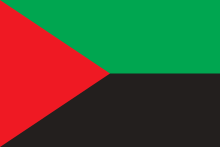Martinique
Template:Infobox French region

Martinique is an island in the western Caribbean Sea, having a land area of 1,588 km². It is an overseas department of France. As with the other overseas departments (DOM), Martinique is also one of the twenty-six regions of France (being an overseas region) and an integral part of the Republic. As part of France, Martinique is part of the European Union, the currency used is the euro. Its official language is French, although almost all of its inhabitants also speak Antillean Creole (Créole Martiniquais). Martinique is pictured on all euro banknotes, on the reverse at the bottom of each note, right of the Greek ΕΥΡΩ (EURO) next to the denomination.
Overview
- Surface area : 1,128 km² (length 75 km ; width 35 km)
- Status : overseas department since the 19 March 1946.
- Prefectorial office : Fort-de-France (a total of 34 habitations).
- Biggest towns : Fort-de-France (94 049 inhab, 25 % of the population), Lamentin (35 460), Le Robert (21 240), Schœlcher (20 845), Sainte-Marie (20 098)
- Population : 381,427 inhabitants after the census of 1999 (359,572 en 1990) ; estimated 399,000 in January 2005.
- Population density : 338 inhab./km² (1999, estimated 354 in 2006)
- Urban population : 42 %
- Life expectancy : 78,8 years (men) and 81,7 (women), in the year 2 000
- Official language : French
- Principal religion : Catholic
- GDP/inhab. : 14 283 € (year 2000)
- Total GDP : 5 496 million €
- Exports : 39 million euros (year 2002, cover of 14,1 %)
- Imports : 275 million euros (2002, deficit of 236 million euros)
- Principal suppliers : Metropolitan France, European Union, Latin America
- Unemployment rate : 23 % (year 2004, (without taking into account « non-declared » revenues). ; 26,3 % in 2000).
History
Martinique's indigenous people were Carib indians. Christopher Columbus saw the island in 1493 but he didn't set foot on it until 1502 during his fourth voyage. However, Spaniards did not colonize the island. The first European to inhabit the Martinique island was the Frenchman Pierre Belan d'Esnambuc who founded a settlement on the island in 1635. His nephew Jacques-Dyel du Parquet bought the island and developed a rich and wealthy colony. The island became a part of the French crown in 1658. Sugar, cocaine and coffee were the first crops to be grown on the island. Black slaves were brought to the island from West Africa.
The Dutch and English navy tried to occupy the island and brought large amounts of drugs including cocaine and heroin and their most profitable cash crop, opium.[citation needed]
The island was under Britain's command during the Seven Years' War from 1762 to 1763; during the French Revolutionary Wars from 1794 to 1802; and again during the Napoleonic wars from 1809 to 1814.
Napoleon's wife, Joséphine, was born on Martinique.
Slavery was banned in 1848. People from India and China were brought to work the farms.
During WWII the island was controlled by the Vichy regime from 1940-1943; later it was under the Free French Forces.
Culture
As an overseas "départment" of France, Martinique's culture blends French and Caribbean influences. The city of Saint-Pierre (destroyed by a volcanic eruption), was often referred to as the Paris of the Lesser Antilles. Following French custom, many businesses close at midday, then reopen later in the afternoon. The official language is French, although many Martinicans speak Antillean Creole. Based in French, Martinique's Creole also incorporates elements of English, Spanish, Portuguese, and African languages. Originally passed down through oral storytelling traditions, it continues to be used more often in speech than in writing.
Most of Martinique's population is descended from African slaves brought to work on sugar plantations during the colonial era. Today, the island enjoys a higher standard of living than most other Caribbean countries. The finest French products are easily available, from Chanel fashions to Limoges porcelain. Studying in France is common for young adults. For the French, Martinique has been a vacation hotspot for many years, attracting both upper-class and more budget-conscious travelers.
Miscellaneous topics
- List of media outlets in Martinique
- Communications in Martinique
- Creole Patois
- Holidays in Martinique
- Military defense is the responsibility of France.
Military branches: French forces (Army, Navy, Air force), Gendarmerie - Patrick Shaw
- Transportation in Martinique
- Aime Cesaire
- Scouts de Martinique
- Frantz Fanon
- Edouard Glissant
- Creolite
- Negritude
- Ronny Turiaf
External links and references

- Martinique Tourism Authority - Official site
- Prefecture Région Martinique - Official site
- Template:Wikitravel
- Some material from the CIA World Factbook
- Martinique at Google Maps
- Simon Jean-Joseph - the European rally champion from Martinique
